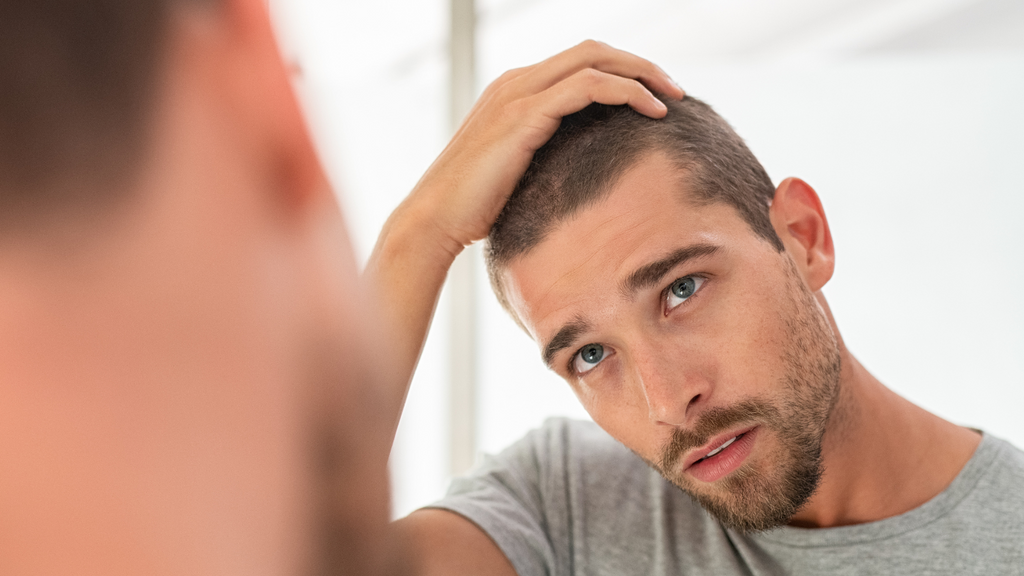Almost half (42%) of all American men between the ages of 18 and 49 now experience moderate to extensive hair loss. Was this really the case one hundred years ago? Probably not.
As our modern lives become increasingly stressful, saturated with toxins, and nutrient-void, we’re beginning to see a sharp rise in male baldness, as well as other health complications.
So, how do we solve this?
✅ Limit stress and do things you enjoy
✅ Reduce exposure to toxins
✅ Stop smoking or vaping
✅ Limit alcohol consumption
✅ Eat a nutrient-rich animal-based diet
✅ Prioritize high-quality sleep
✅ Exercise regularly
Let’s stop blaming “bad genetics” for everything and first evaluate our dietary and lifestyle choices.
1. Bears in the Wild vs. Bears in the Zoo

Here’s a thought experiment: bears in the wild don’t go bald. Bears in captivity often do. Why? Stress, artificial environments, and a lack of natural food sources. Sound familiar? Modern society is essentially one big zoo. Processed food, constant stimulation, and cubicle living put us in the same situation as those captive animals. Balding might be less about “unlucky genes” and more about living unnaturally.
2. The Homeless Man Paradox

Ever notice the irony? The average guy in his 20s is living in a sleek apartment, dropping serious cash on expensive shampoos, yet he’s going bald. Meanwhile, the homeless man down the street often has a full, thick head of hair. Of course, there are exceptions, but the meme points out something important: sometimes modern comforts don’t equate to better health. Instead, they expose us to more toxins, poor diets, and stressors that impact everything, including hair.
3. Balding Isn’t Just Genetics

The narrative that balding is “inevitable” ignores a mountain of evidence. Diet, lifestyle, nutrient deficiencies, and toxic exposures all play massive roles. Low zinc, iron, and vitamin D levels are linked to hair loss. Endocrine-disrupting chemicals in plastics, personal care products, and even food packaging can throw hormones off balance, leading to thinning hair. Genetics may load the gun, but lifestyle pulls the trigger.
4. The Smoking Twin

Twin studies are fascinating. Take two identical twins—same DNA, same genetic “risk.” One smokes and drinks regularly, the other doesn’t. Guess which one goes bald faster? Research shows smoking accelerates hair loss, damages follicles, and impairs circulation to the scalp. Alcohol compounds the effect by depleting B-vitamins and raising stress hormones. Lifestyle matters more than most people want to admit.
5. The Stressed-Out Twin

Now imagine another set of twins. One lives a relatively low-stress lifestyle, the other is constantly anxious, sleep-deprived, and overworked. The stressed twin is far more likely to shed hair early. Cortisol, the body’s stress hormone, shortens the hair growth cycle and can trigger premature follicle miniaturization. Hair is one of the first things to show when the body is in distress.
6. The Cubicle Conundrum

Modern living means fluorescent lights, endless emails, and being chained to a desk for 8–10 hours a day. But is this how we’re supposed to be living? Our ancestors spent their days in the sun, moving, hunting, building, and connecting face-to-face. Today, we sit in boxes, stare at screens, and eat food wrapped in plastic. It’s no wonder chronic disease and balding are on the rise.
7. The Homestead Dream

When asked what they really want, many men say the same thing: escape the grind and live somewhere quiet, in tune with nature, maybe on a homestead in the middle of nowhere. It’s not just a fantasy—it’s biology calling. Simpler living with nutrient-dense food, daily movement, sunlight, and low stress could be the best “hair restoration” plan nature ever designed.
Closing Thoughts
Male balding isn’t destiny. It’s not just genetics. It’s a signal from your body that modern living has gone off track. When you step back, limit toxins, eat real food, and prioritize sleep, stress reduction, and movement, you give your body the tools it needs to thrive. Maybe instead of asking, “Why am I going bald?” the better question is, “Am I living the way humans were meant to live?”
References
- Trüeb, Ralph M. "Oxidative Stress in Ageing of Hair." International Journal of Trichology, vol. 1, no. 1, 2009, pp. 6–14.
- Paus, Ralf, and Kurt Stenn. "Telogen Effluvium and Other Hair Loss Disorders in Captive Mammals." Veterinary Dermatology, vol. 10, no. 3, 1999, pp. 231–236.
- Su, Li-Hui, and Hui-Hsien Chen. "Smoking as a Risk Factor for Male Pattern Baldness: A Case-Control Study." Archives of Dermatology, vol. 143, no. 11, 2007, pp. 1401–1406.
- Trüeb, Ralph M. "Nutritional Deficiencies and Hair Loss: The Evidence and Its Limitations." Dermato-Endocrinology, vol. 1, no. 5, 2009, pp. 289–294.
- Arck, Petra, et al. "Stress Inhibits Hair Growth in Mice by Induction of Premature Catagen Development and Downregulation of anagen-associated Growth Factors." Proceedings of the National Academy of Sciences, vol. 100, no. 19, 2003, pp. 10393–10398.
- Trüeb, Ralph M. "Molecular Mechanisms of Androgenetic Alopecia." Experimental Gerontology, vol. 37, no. 8-9, 2002, pp. 981–990.
- Ling, Tien-Han, et al. "Alcohol Consumption and Hair Loss in Men: A Population Study." Journal of Public Health Nutrition, vol. 17, no. 5, 2014, pp. 1123–1130.

